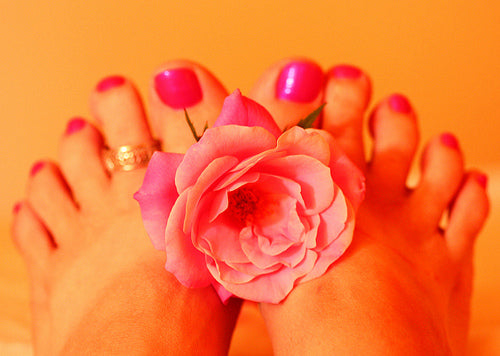Pedicures to Make Your Toes Twinkle (Safely)
Posted by JB Smith, Co-Owner on

Ah, spring, summer, sunshine, long walks on the beach! Good weather means finally letting your feet out for a breather after the cold endless winter months. And how better to celebrate your newfound freedom from heavy boots and thick woolen socks than a trip to the nail salon for a little foot pampering? You deserve a little TLC! But before you go, make sure you know the ins and outs of pedicure safety; in the wrong hands, a pedicure can lead to infections and other health complications.
First off, what exactly constitutes a pedicure?
If you find yourself sitting in a comfortable recliner with one foot in a basin and the other being smoothed by a pumice stone, you’ve hit jackpot. Any kind of toenail trimming, skin care treatment or massage of the foot to enhance appearance or overall comfort would be considered a pedicure.
What should you be looking out for when you pick a salon?
Cleanliness really is key here. All tools should be kept in disinfection containers with clear solution, and service providers should be washing hands frequently and wearing gloves. Perhaps give the salon a try with a manicure first. Always trust your instincts; if the salon looks untidy or smells overperfumed, walk out.
Tips for pedicure safety:
- Make an appointment for the beginning of the day, when instruments and footbaths tend to be their cleanest.
- Make sure there is enough time scheduled between appointments to ensure that the salon has enough time to properly clean all materials. (It takes at least 10 minutes for disinfectants to work.)
- Resist the bubbles of the footbath. Pipes tend to not be cleaned throughout the day; while the tub may be sterilized, bacteria can enter the bath once the jets start. Better yet, go with a salon that has pipeless foot spas.
- Don’t perform any hair-removal treatments on your legs in the 24 hours before the pedicure to keep bacteria and fungus from entering through unnoticeable cuts or abrasions (48 hours if you have diabetes).
- Bring your own pedicure tools, especially those that cannot be properly sterilized (like nail buffers).
- Don’t have your cuticles cut or pushed back.
- Pick a salon that uses stainless steel instruments, which are easiest to clean.
- Make sure your pedicure technician uses a pumice stone or foot file, and not a razor-type tool for dead skin removal.
- Use pedicure-specific products that are oil-free and allow the skin the breathe.
Can you get a pedicure if you have diabetes?
When you have diabetes, keeping your feet healthy and injury-free is of the utmost importance. While pedicures can be a great way to maintain clean and hydrated feet, which is vital in managing the disease, you should be extra vigilant in taking the necessary steps to avoid infection.
- Strictly follow the general pedicure tips above.
- Speak with your doctor about guidelines specific to your health condition to discuss with your pedicure technician.
- Let the salon know about your diabetes.
- Make sure the water is kept below 95 degrees.
- Avoid excess moisturizer between the toes.
- Watch out for dehydrating foot scrubs.
- Use a salon that operates an autoclave (a hot, pressurized chamber used to sterilize medical instruments).
- Request that toenails be cut straight across.
And remember, no pedicures if you have neuropathy or foot ulcers!
Is there such a thing as a waterless pedicure?
Known as a medical pedicure, this treatment excludes water application completely. Instead of soaking in a basin, technicians clean the feet with a disinfectant solution and use softening compounds that only affect the dead skin. A machine with specially-designed nozzles is used to treat all areas of the foot in a non-abrasive manner. This is believed to minimize the chance of injury and the spread of potential fungus diseases. These types of pedicures may be recommended for clients with diabetes or circulatory problems.
Strange but true: Time for a nibble?
One of the strangest beauty treatments of the last couple of years (especially in Europe) has been what’s known as the “fish pedicure,” during which your feet rest in a shallow basin of water for 15 minutes while fish suck the dead skin off your feet. Garra ruffa (or doctor fish) are a type of carp that have been used in skin treatments for centuries in Turkey, Asia and the Middle East. While there have yet to be conclusive studies on the risks involved, there is a real concern among health organizations that the fish could spread disease since the same fish are used for multiple treatments. For this reason, several states have outlawed the “fish pedicure” – so we tend to err on the side of caution with this one!
